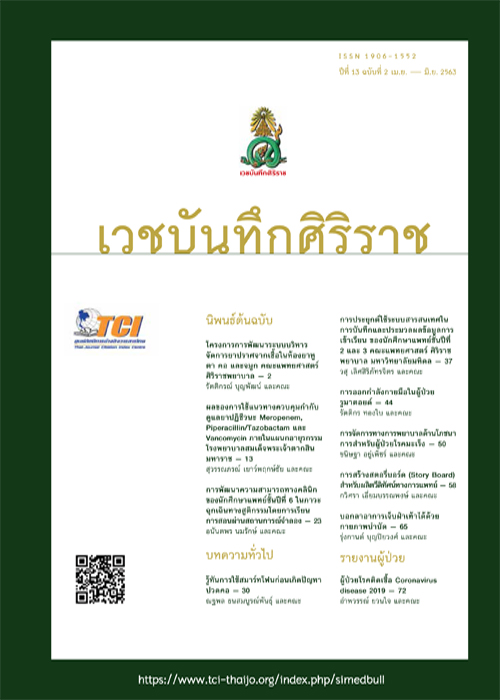รู้ทันการใช้สมาร์ทโฟนก่อนเกิดปัญหาปวดคอ
Main Article Content
Abstract
Abstract
Nowadays, Number of communication devices has been using in our daily lives, for example, mobile phones, smartphones, and tablets. Most people spend a lot of time using those devices for communicating or information searching. Consequently, musculoskeletal problem related smartphone using appear on their body parts, especially on the neck and the shoulder. The alignment of their cervical spine and muscles would be affected when they are looking down on the devices for a long period and resulting in neck and shoulder pain. The problem can be solved or lessen by adjusting their posture, reducing time spending on the devices or doing the neck exercise or muscle stretching to strengthen and give the flexibility to the neck part.
Keywords; craniocervical neck exercise, mobile, neck pain, smartphone.
Article Details
References
2. บทสรุปสำหรับผู้บริหารการมีการใช้เทคโนโลยีสารสนเทศและการสื่อสารในครัวเรือนพ.ศ.2559.
3. Halloran L. Mobile Devices Can Be a Real Pain. The Journal for Nurse Practitioners 2015;11:832-3.
4. Hansraj KK. Assessment of stresses in the cervical spine caused by posture and position of the head.
Surgical Technology International 2014;25:277-9.
5. เอกสารคำสอนเรื่องกระดูกสันหลังและกระดูกสันหลังระดับคอ. จิตวรี ขำเดช.โรงเรียนกายภาพบำบัด คณะแพทยศาสตร์ศิริราชพยาบาล.[ม.ป.ป.].
6. อารยา เสงี่ยมพงษ์, นัทธมน ภูรีพัฒน์พงค์ คงคาสุริยฉาย. กายวิภาคศาสตร์ของโครงกระดูกมนุษย์ [ม.ป.ป.]:
69-72.
7. อำนวย อุนนะนันทน์. เรื่องของกระดูกสันหลังที่ควรรู้. พิมพ์ครั้งที่ 1.กรุงเทพฯ:งานตำราวารสารและสิ่งพิมพ์ สถานเทคโนโลยีการศึกษาแพทยศาสตร์ คณะแพทยศาสตร์ศิริราชพยาบาล มหาวิทยาลัยมหิดล;2542.
8. Lee S, Kang H, Shin G. Head flexion angle while using a smartphone. Ergonomics 2515;58:220-26.
9. Guan X, Fan G, Chen Z, Zeng Y, Zhang H, Hu A. Gender difference in mobile phone use and the impact of digital device exposure on neck posture. Ergonomics 2016;58:1453-61.
10. Bo-Been Kim, Ji-Hyundai Lee, Hyo-Jung Jung Jeong, Heon-Seock Cynn. Effects of suboccipital release with craniocervical flexion exercise on craniocervical alignment and extrinsic cervical muscle activity in subjects with forward head posture. Journal of electromyography and kinesiology 2016;40:31-7.
11. Brage K, Ris I, Falla D, Sogaard K, Juul-kristensen B. Pain education combined with neck-and aerobic training is more effective at relieving chronic neck pain than pain education alone-A preliminary randomized controlled traial. Manual Therapy 2015;20:686-93.
12. Falla DL, Jull GA, Hodges PW. Patients with Neck Pain Demonstrate Reduced Electromyographic Activity of the Deep Cervical flexor Muscle During Performance of the Craniocervical flexion Test.
Spine 2004;29:2108-14.
13. Borenstein DG, Wiesel SW, Bowden SD. Neck pain medical diagnosis comprehensive management. 1st ed. Philadelphia: W.B.Saunders company; 1996.
14. Seong-Yeolkim, Sung-Ja Koo. Effect of duration of smartphone use on muscle fatique and pain caused by forward head posture in adults. The Journal of Physical Therapy Science 2016;28:1669-72.
15.Seo-Yeung Gu, Gak Hwangbo, Jeon-Hyeong Lee. Relationship between position sense and reposition errors according to the degree of upper crossed syndrome. The Journal of Physical Therapy Science 2016;28:438-41
16. สุวิมล ตั้งสัจจพจน์. หลักการออกกำลังกาย; 2526. หน้า 1-9.
17. เสก อักษรานุเคราะห์. การออกกำลังกายสำหรับคนวัยเสื่อม; 2525. หน้า 74-8.
18. ชูศักดิ์ เวชแพศย์. สรีรวิทยาของการออกกำลังกาย. พิมพ์ครั้งที่ 2;2525. หน้า 103-9.
19. แผ่นพับกายภาพบำบัดสู่ประชาชนเรื่องปวดคอ.สาขากายภาพบำบัดภาควิชาศัลยศาสตร์ออร์โธปิดิคส์และกายภาพบำบัด คณะแพทยศาสตร์ศิริราชพยาบาล SIPT ORT 1001158 เรียบเรียงโดย รุ่งกานต์ บุญปิยวงศ์, ทิพย์อาภรณ์ เรืองวุฒิสกุลชัย.


